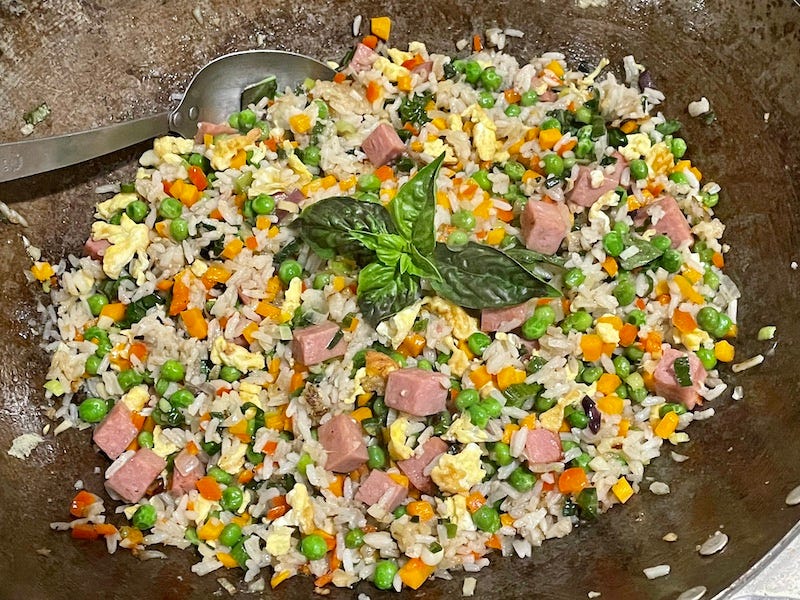I love fried rice. Don’t you? Whenever I order fried rice in a Chinese restaurant, the rice grains never clump up into damp blobs, which is what usually happens when I make fried rice at home.
What’s the secret to perfect fried rice? The short answer is controlling the rice’s starch content. The less starch on the grain surfaces, the less chance they’ll stick to each other.
The easiest and best way to remove surface starch is to swish the raw rice in a bowl of cool tap water for about half a minute, drain the rice in a wire strainer and run cool water over the rice as you move the rice around with your hand to remove any remaining surface starch. Once the excess surface starch has been washed away, you’re ready to cook the rice.
And what type of rice should you use? A medium grain rice for risotto, such as Arborio or Carnaroli is ideal.
I’ve always used long grain rice, and that’s been part of my problem with fried rice. It’s a lot starchier than medium grain rice.
Most fried rice recipes say to use leftover cold rice. But it’s important to rinse the rice before cooking.
Once cooked, spread the hot rice evenly on the bottom of a large (12 x 18- or 11 x 17-inch) rimmed sheet pan. Cool the rice with a fan, stirring the rice occasionally. The fan serves to dry the surface of the rice grains, insuring that they stay separate during cooking.
And if you do refrigerate the rice, do not cover it tightly. Spread it on a 13 x 9-inch baking pan, cover loosely with paper towels, and refrigerate. You want the rice surface to remain dry.
To cook the rice for this recipe, bring 3 cups water to the boil in a 3-quart saucepan. Stir in 1 ½ cups rinsed raw rice, bring water back to the boil, and cover the pan. Reduce the heat so that the water bubbles slowly. Cook about 20 minutes, until the rice is tender to the bite. The rice is ready to be fanned and cooled as described above.
Fried rice is the star of the show, so vegetable and meat additions should just be supporting players.


It’s important to keep liquid additions to a minimum or the rice is apt to become gummy. That’s why salt is the major seasoning and any sauce addition is added at the last minute.
So, on your mark, get set, cook!
The Fried Rice Recipe
Feel free to vary the vegetables according to your taste, but carrots and peas are considered essential. Have all ingredients ready before you start cooking.
Makes 4 to 6 servings
4 cups (500 grams) cooked cooled or cold rice
Cooking oil—coconut, avocado, or peanut
1 tablespoon finely chopped ginger
1 tablespoon finely chopped garlic
1 cup finely diced peeled carrot
1 cup finely diced red bell pepper
1 cup finely chopped yellow onion
4 large scallions, ends trimmed, white and green parts sliced thin
1 ½ cups frozen peas
2 large eggs, lightly beaten with a fork
1 cup diced cooked protein: Spam, chicken, shrimp, or tofu
About ½ cup torn basil leaves, or chopped cilantro or parsley
Salt
Sesame oil
Final seasonings: soy cause, fish sauce, or oyster sauce
1. If using cold cooked rice, break up any clumps with your fingers to separate the grains.
2. Set a wok over high heat. When hot, add 2 tablespoons oil, swirl it round the pan, and add the ginger and garlic. Stir and cook about 30 seconds, until fragrant.
3. Add the carrot, bell pepper, onion and scallions. Stir and cook 1 to 2 minutes, until vegetables are crisp-tender. Add the frozen peas and cook, stirring, about 30 seconds more. Transfer the vegetables to a side dish.
4. Add 1 tablespoon oil to the wok, swirl it around and pour in the beaten eggs. Working quickly, swirl the eggs around the work and use a fork to manipulate them until they set. This only takes a few seconds. Dump the eggs out onto a cutting surface and dice them coarsely.
5. Return the wok to high heat. Add 3 tablespoons oil, swirl it around in the pan, and add the rice. Immediately start tossing the rice around with a wooden spoon in rapid movements to coat each grain. Keep moving the rice round for about 2 minutes until the rice is very hot.
6. Add the cooked vegetables, egg, protein, and herb of choice, and toss well. Take the wok off the heat. Season fried rice with 1 teaspoon table salt, mixing well. Taste and add more salt if you want.
7. Drizzle in 1 tablespoon roasted sesame oil, mix well, and portion into heated serving bowls. Season with 1 teaspoon of chosen sauce for each portion and serve.







Your recipe looks exciting and unique, with delicious results! Not only does it offer reduced starchiness but appears to be healthier than restaurant fried rice. Thanks, Mr. Patent. You make
this dish look patently easy...accept the pun! SED-B author and marketeer
i love your new pineapple-y logo. and also: you have me in the mood to make fried rice now!